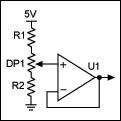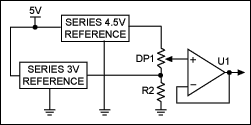

Ratiometric Design Overcomes t
通信设计应用
64人已加入
描述
Abstract: This application note explains how to eliminate the voltage change when a digital potentiometer is used as a voltage-divider in series with other resistors.
This application note discusses a ratiometric method to convert that resistance tolerance into an acceptable current change. The proposed design also effectively removes the voltage change. In the circuit presented here the voltage output depends only on the ratio of the steps of the pot. The temperature coefficient is better controlled in the design.

Figure 1. Basic schematic.
Now consider the same design with a different pot. If the pot is 37.5kΩ, the top of the pot is 4.46V and the bottom is 3.25V. Continuing on, if the pot is 62.5kΩ, the top of the pot is 4.54V and the bottom is 2.79V. This basic approach does not solve the changing voltage problem because the pot's end-to-end tolerance is in the circuit.
The next circuit in Figure 2 only uses the pot's ratio.

Figure 2. Alternate design features two voltage references.
By using two voltage references the tolerances and the temperature coefficient are controlled. The absolute end-to-end tolerance of the digital pot changes the current, but does not affect the voltage. The output voltage is ratiometric; the voltage out depends only on the ratio of the steps of the pot.
Both references use feedback to control the output voltage. R2 (~25K to 50K) ensures that both references source current. Bypass capacitors are discussed in the data sheet for each Maxim digital pot. Some capacitors may be required, depending on the board layout.
Ultimately, an application dictates the system's requirements. Device temperature coefficients can be predicted from the respective digital pot data sheets. The pots also offer a choice of noise specifications. Maxim's complete list of digital pots and voltage references is available on the website.
打开APP阅读更多精彩内容
Introduction
Mechanical and electronic digital potentiometers tend to have loose end-to-end tolerances. Maxim digital pots typically have a 20% to 30% resistance tolerance. The resistance tolerance can be problematic when the digital pot is used as a voltage-divider in series with other resistors. That configuration will result in an unacceptable voltage change over tolerance.This application note discusses a ratiometric method to convert that resistance tolerance into an acceptable current change. The proposed design also effectively removes the voltage change. In the circuit presented here the voltage output depends only on the ratio of the steps of the pot. The temperature coefficient is better controlled in the design.
Ratiometric Method for the Design
The design challenge is straightforward: a variable voltage between 3V and 4.5V with a tolerance of 3%. Start with the schematic in Figure 1 and do the math. The digital pot is 50kΩ (25% tolerance); R1 is 16.5K (1%) and R2 is 100K (1%). The 25% tolerance of the pot's end-to-end resistance will dominate in this design.
Figure 1. Basic schematic.
Now consider the same design with a different pot. If the pot is 37.5kΩ, the top of the pot is 4.46V and the bottom is 3.25V. Continuing on, if the pot is 62.5kΩ, the top of the pot is 4.54V and the bottom is 2.79V. This basic approach does not solve the changing voltage problem because the pot's end-to-end tolerance is in the circuit.
The next circuit in Figure 2 only uses the pot's ratio.

Figure 2. Alternate design features two voltage references.
By using two voltage references the tolerances and the temperature coefficient are controlled. The absolute end-to-end tolerance of the digital pot changes the current, but does not affect the voltage. The output voltage is ratiometric; the voltage out depends only on the ratio of the steps of the pot.
Both references use feedback to control the output voltage. R2 (~25K to 50K) ensures that both references source current. Bypass capacitors are discussed in the data sheet for each Maxim digital pot. Some capacitors may be required, depending on the board layout.
Ultimately, an application dictates the system's requirements. Device temperature coefficients can be predicted from the respective digital pot data sheets. The pots also offer a choice of noise specifications. Maxim's complete list of digital pots and voltage references is available on the website.
声明:本文内容及配图由入驻作者撰写或者入驻合作网站授权转载。文章观点仅代表作者本人,不代表电子发烧友网立场。文章及其配图仅供工程师学习之用,如有内容侵权或者其他违规问题,请联系本站处理。
举报投诉
- 相关推荐
- 热点推荐
- design
-
8T49N281-003 数据表 Tilera Reference Design2023-03-24 301
-
Design Compiler打开方式2021-07-26 1704
-
ISE Design Suite是否支持Spartan-6 LX150T开发套件2018-11-26 1759
-
Cadence_OpAmp_Schematic_Design_T2016-02-22 1261
-
多远程二极管温度传感器 (Design Considerat2010-11-21 781
-
Ratiometric Sensing Using the2010-05-20 521
-
The Design and Simulation of t2010-03-03 490
-
Advanced Digital Design with t2009-07-23 921
-
Creating a Ratiometric Current2009-04-20 1433
-
Ratiometric Design Overcomes t2008-10-01 873
-
AsynchronousvsSynchronous Circuit Design2008-09-11 4304
-
MAX3580 DVB-T Reference Design2008-08-18 2242
全部0条评论

快来发表一下你的评论吧 !

